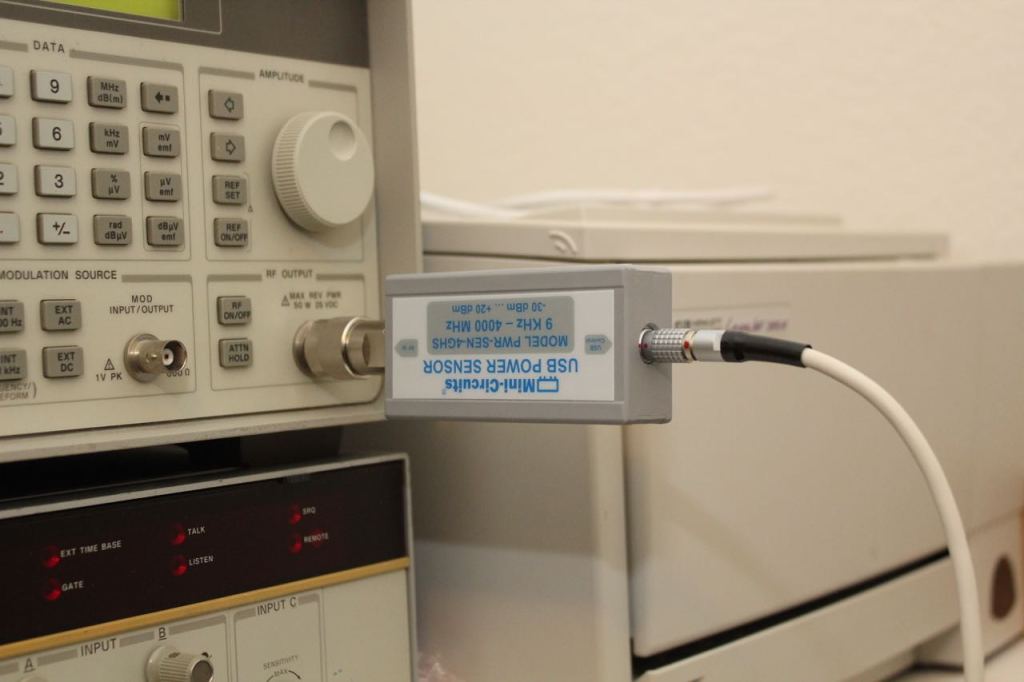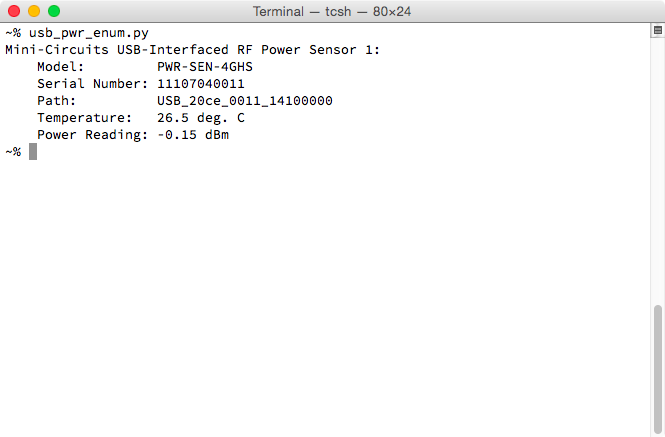Well, that didn’t take long. As mentioned in my previous post, I’ve just created a Python package providing support for Mini-Circuits brand portable test equipment. Well, more accurately, it just provides support for my model PWR-SEN-4GHS USB-interfaced RF power sensor (and probably the other sensors in that product line), since that’s the only piece of Mini-Circuits test gear that I have.
If anybody would like to loan me other items from the Mini-Circuits portable test equipment line, then I’ll consider adding support for it to this package. Hello, Mini-Circuits… ;)
I wrote this so that I can use my RF power sensor under OS X on my Mac. This package requires my pyhidapi package, as well as the hidapi library (which is written by another author).
Here’s a picture of my sensor plugged into my HP 8648A signal generator for testing.
And here’s a screen shot, showing invocation of a utility script that’s included with pyMiniCircuits. This was run on my Mac under OS X 10.10.1 "Yosemite".
The pyMiniCircuits source code is released under GPLv3, and is available on GitHub:


I am looking for reviews of the PWR-4GHS. I am considering the purchase of one, and I would like some independent feedback on the device.
It works as advertised, and the construction quality is quite good. I didn’t have much trouble getting it working on my unsupported Mac, and the code I’ve shared here may help folks who aren’t comfortable programming around mid-level USB drivers. I would prefer that they made it a USB TMC device instead of a USB HID device for consistency with other programmable test equipment, but I can understand their choice to make it an HID device. A non-frequency-selective power meter is a pretty basic piece of test gear for radio development. For measuring higher power levels, I got a set of 2W attenuators from Mini-Circuits, and a great big 500W 500MHz 30dB attenuator from eBay. I also have a Pasternack PE7033-2 step attenuator that I found unusually cheaply on eBay, and it turned out that the 20dB step is burned out. I may try to fix it someday, but for now I just don’t use that step.
I hope that you’ll get some other reviews, but you might need to ask elsewhere besides my obscure little blog.
Mark:
Thanks for your review.
I purchased a PWR-4GHS power meter from Minicircuits. It seems to work as advertised, so I am pleased. Like you, I have a number of attenuators to use with the device, including a large, oil-filled 500watt, 30dB unit from Bird (probably the same as yours). With my VNA, at any number of frequencies, I can measure an attenuator’s exact attenuation. As an offset value, this data is entered into the PWR-4GHS software to produce a meter capable of high-power reading. Also, I have a number of homemade directional couplers that I have characterized with my VNA. I plan to use these couplers with the power meter.
73,
John, n5df
I think that setup will work very well for you.
73